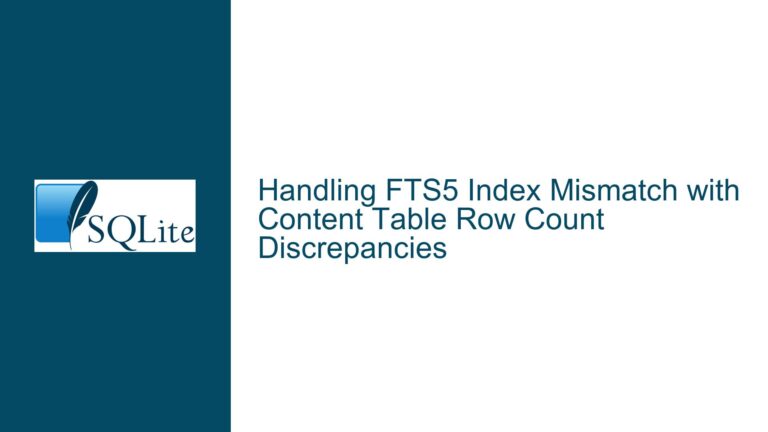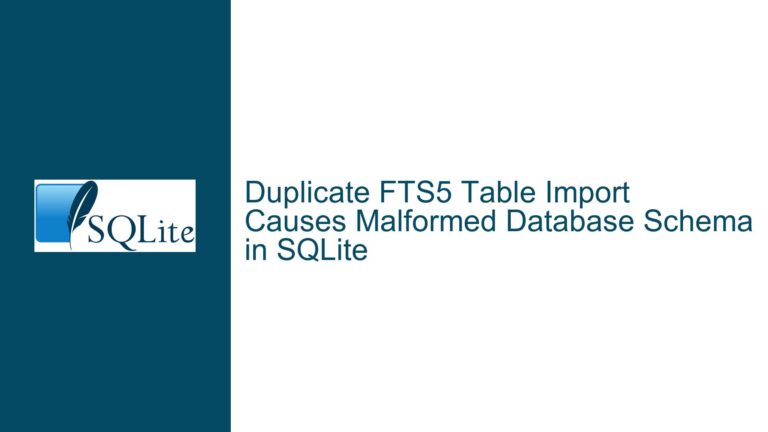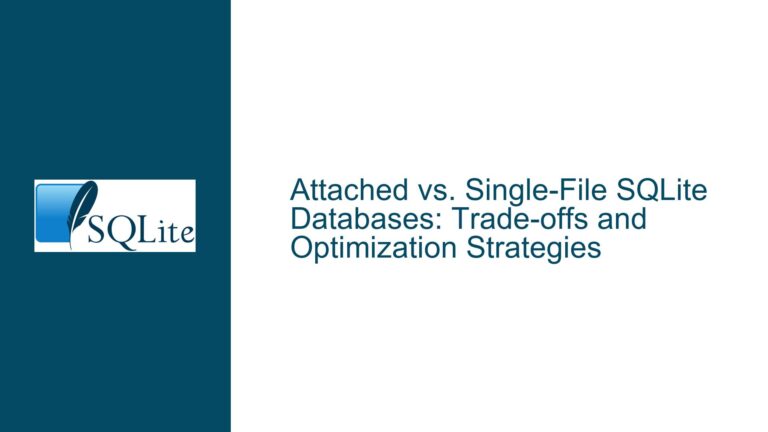Using Timestamps as Unique IDs in SQLite: Risks and Solutions
Timestamps as Unique Identifiers: Reliability and Long-Term Considerations
The use of timestamps as unique identifiers in SQLite databases is a common practice, especially in applications where time-based ordering or uniqueness is required. However, relying solely on timestamps for uniqueness introduces several risks, particularly over long-term usage. This post delves into the nuances of using timestamps as unique IDs, explores the potential pitfalls, and provides detailed solutions to ensure data integrity and reliability.
System Clock Arbitrariness and Microsecond Collisions
The primary concern with using timestamps as unique identifiers lies in the inherent nature of system clocks. System clocks can be manually set to arbitrary times, which can lead to timestamp collisions. Even with microsecond precision, the risk of collision, while low, is not zero. This is particularly problematic in high-activity systems where multiple entries might be generated within the same microsecond.
In SQLite, the unixepoch function or Tcl’s clock microseconds can be used to generate timestamps. However, these methods are not foolproof. For instance, if a user opens the same SQLite database on different operating systems, the system clocks on these machines might not be synchronized, leading to potential timestamp conflicts. Over a span of twenty years, the likelihood of such conflicts increases, especially if the database is accessed from multiple devices with varying clock settings.
Moreover, even within a single system, the precision of timestamps can be a limiting factor. As noted in the Fossil project (SQLite’s SCM), there have been instances where developers committed code within the same second, highlighting the risk of collisions even with second-level precision. While microsecond precision reduces this risk, it does not eliminate it entirely.
Randomness and Seed Initialization in randomblob
To mitigate the risks associated with timestamp-based unique IDs, one alternative is to use SQLite’s randomblob function, which generates a random binary large object (BLOB). This function can be combined with a timestamp to create a more robust unique identifier. For example:
select datetime() || ' ' || lower(hex(randomblob(10)));
This approach appends a random string to the timestamp, significantly reducing the likelihood of collisions. However, it is essential to understand how randomblob initializes its randomness. The function relies on a pseudo-random number generator (PRNG) that requires a seed. On Unix systems, the PRNG is typically seeded from /dev/urandom. If this fails, it falls back to using a combination of the system time and the process ID. On Windows, the seed is created from a combination of the clock, process ID, and other OS-provided sources.
While this method enhances uniqueness, it is not entirely foolproof. The randomness of randomblob is dependent on the quality of the seed. In scenarios where the seed is compromised or predictable, the generated IDs might not be as unique as expected. Therefore, it is crucial to ensure that the PRNG is adequately seeded, especially in environments where high uniqueness is required.
Long-Term Database Maintenance and Backup Strategies
Beyond the immediate concerns of unique ID generation, long-term database maintenance is another critical aspect to consider. Over time, a SQLite database file can undergo significant changes, especially in applications where data is frequently added, modified, or deleted. This raises questions about the database’s longevity and the potential for data corruption or fragmentation.
SQLite’s file format is designed for stability and long-term archival. The United States Library of Congress endorses SQLite for long-term archival, and the SQLite team guarantees support for the file format through at least 2050. However, this does not absolve developers from implementing proper maintenance and backup strategies.
One common issue in long-term database usage is the accumulation of deleted records. SQLite reuses space in the database, overwriting deleted records with new ones. While this is efficient, it can lead to fragmentation over time, especially in databases with high turnover rates. Running the VACUUM command periodically can help mitigate this issue by reorganizing the database file and reclaiming unused space.
Additionally, implementing a robust backup strategy is essential. Regular backups should be performed and tested to ensure data integrity. SQLite provides the VACUUM INTO command, which allows for the creation of a backup file:
VACUUM INTO 'backup_filename.db';
This command creates a compact and optimized copy of the database, which can be used for backup purposes. It is also advisable to store backups in geographically diverse locations to protect against catastrophic hardware failure.
Handling Data Overwriting and Fragmentation
In applications where data is frequently overwritten, such as note-taking tools with extensive editing capabilities, the database can experience significant fragmentation. This is particularly true when using methods like the piece-table approach, which generates numerous rows of data that are eventually deleted. While SQLite handles space reuse efficiently, excessive fragmentation can impact performance.
To address this, developers should consider running the VACUUM command periodically to defragment the database. Additionally, monitoring the database’s size and performance can help identify when maintenance is needed. In some cases, it might be beneficial to export the data to a new database file, effectively starting with a clean slate.
Ensuring Data Consistency Across Transfers
Another long-term consideration is the transfer of database files between different machines or storage media. Over time, as hardware evolves, database files may be moved to new systems. It is crucial to verify the integrity of the database after each transfer. Rare events, such as disk read/write errors or network issues during transfer, can introduce corruption.
To mitigate this risk, developers should implement checksum verification or use tools like SQLite’s integrity_check pragma to ensure data consistency. Additionally, maintaining multiple backups and not discarding old backups can provide an additional layer of security against data loss.
Conclusion
Using timestamps as unique identifiers in SQLite databases is a viable approach, but it comes with inherent risks, particularly over long-term usage. System clock arbitrariness and microsecond collisions can lead to non-unique IDs, while the initialization of randomness in randomblob introduces its own set of challenges. To ensure data integrity and reliability, developers should consider combining timestamps with random strings, implementing robust backup strategies, and performing regular database maintenance.
Long-term database maintenance, including periodic VACUUM operations and careful monitoring of data fragmentation, is essential to keep the database performing optimally. Additionally, ensuring data consistency across transfers and maintaining multiple backups can protect against rare but potentially catastrophic events.
By understanding these nuances and implementing the appropriate solutions, developers can leverage SQLite’s strengths while mitigating the risks associated with long-term database usage. This approach not only ensures the reliability of unique identifiers but also contributes to the overall stability and longevity of the database.






